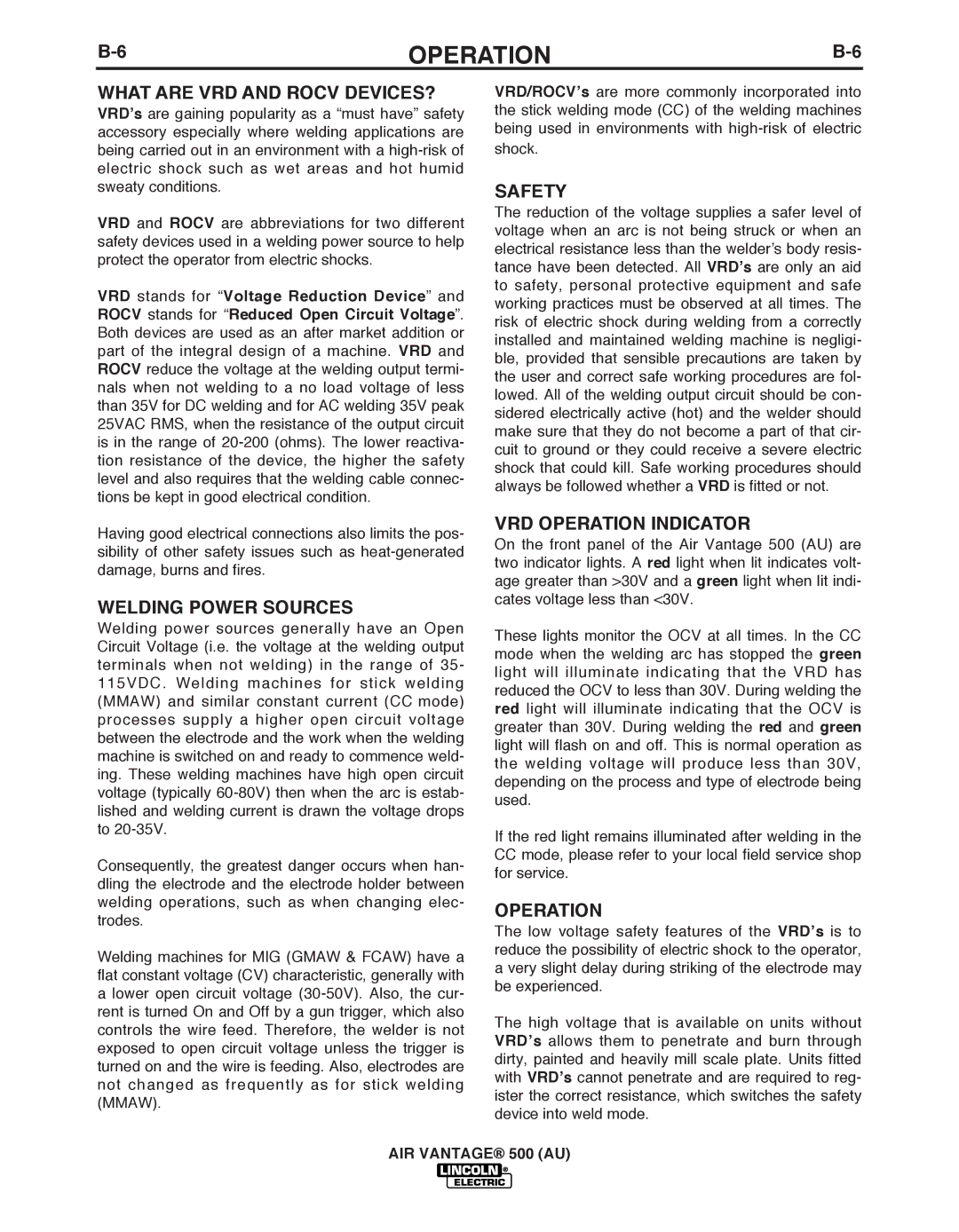OPERATION | ||
|
|
|
WHAT ARE VRD AND ROCV DEVICES?
VRD’s are gaining popularity as a “must have” safety accessory especially where welding applications are being carried out in an environment with a
VRD and ROCV are abbreviations for two different safety devices used in a welding power source to help protect the operator from electric shocks.
VRD stands for “Voltage Reduction Device” and ROCV stands for “Reduced Open Circuit Voltage”. Both devices are used as an after market addition or part of the integral design of a machine. VRD and ROCV reduce the voltage at the welding output termi- nals when not welding to a no load voltage of less than 35V for DC welding and for AC welding 35V peak 25VAC RMS, when the resistance of the output circuit is in the range of
Having good electrical connections also limits the pos- sibility of other safety issues such as
WELDING POWER SOURCES
Welding power sources generally have an Open Circuit Voltage (i.e. the voltage at the welding output terminals when not welding) in the range of 35- 115VDC. Welding machines for stick welding (MMAW) and similar constant current (CC mode) processes supply a higher open circuit voltage between the electrode and the work when the welding machine is switched on and ready to commence weld- ing. These welding machines have high open circuit voltage (typically
Consequently, the greatest danger occurs when han- dling the electrode and the electrode holder between welding operations, such as when changing elec- trodes.
Welding machines for MIG (GMAW & FCAW) have a flat constant voltage (CV) characteristic, generally with
alower open circuit voltage
VRD/ROCV’s are more commonly incorporated into the stick welding mode (CC) of the welding machines being used in environments with
SAFETY
The reduction of the voltage supplies a safer level of voltage when an arc is not being struck or when an electrical resistance less than the welder’s body resis- tance have been detected. All VRD’s are only an aid to safety, personal protective equipment and safe working practices must be observed at all times. The risk of electric shock during welding from a correctly installed and maintained welding machine is negligi- ble, provided that sensible precautions are taken by the user and correct safe working procedures are fol- lowed. All of the welding output circuit should be con- sidered electrically active (hot) and the welder should make sure that they do not become a part of that cir- cuit to ground or they could receive a severe electric shock that could kill. Safe working procedures should always be followed whether a VRD is fitted or not.
VRD OPERATION INDICATOR
On the front panel of the Air Vantage 500 (AU) are two indicator lights. A red light when lit indicates volt- age greater than >30V and a green light when lit indi- cates voltage less than <30V.
These lights monitor the OCV at all times. In the CC mode when the welding arc has stopped the green light will illuminate indicating that the VRD has reduced the OCV to less than 30V. During welding the red light will illuminate indicating that the OCV is greater than 30V. During welding the red and green light will flash on and off. This is normal operation as the welding voltage will produce less than 30V, depending on the process and type of electrode being used.
If the red light remains illuminated after welding in the
CCmode, please refer to your local field service shop for service.
OPERATION
The low voltage safety features of the VRD’s is to reduce the possibility of electric shock to the operator, a very slight delay during striking of the electrode may be experienced.
The high voltage that is available on units without VRD’s allows them to penetrate and burn through dirty, painted and heavily mill scale plate. Units fitted with VRD’s cannot penetrate and are required to reg- ister the correct resistance, which switches the safety device into weld mode.
AIR VANTAGE® 500 (AU)
